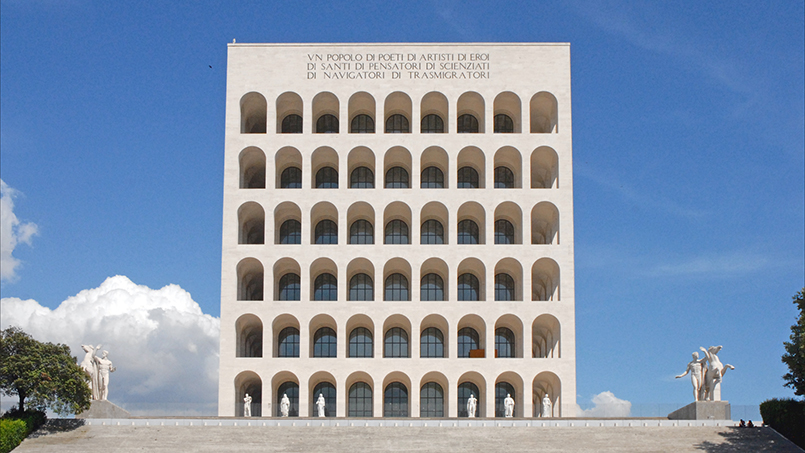The Bear… in Rome: the city’s groundbreaking chefs
- December 31, 2024
- Food & Drinks, Prati area, Trastevere area

“Rome the Second Time” is the title of a well-known travel guide which offers, as per its cover, “15 itineraries that don’t go to the Coliseum”. This post takes a leaf from that book, by offering alternative, modern sights to return visitors as well as first-time tourists who may want to venture away from well-known landmarks.
While Rome is famous for its ancient remains or the Baroque-heavy palaces in the center, the city is no stranger to much more modern architectural style. Art nouveau, futurist or modernist buildings abound around here, but for the sake of this particular post, we’d like to concentrate on more noticeable examples such as brutalist or rationalist estates.
First appearing during the 17th century and strongly inspired by Vitruvius’s ideas on rational thinking applied to architecture, Rationalism really struck big in Italy in the 1920s and 1930s. Some of the best known architects in this style come from Italy. Rationalist architecture is strongly associated with the Fascist era, and it makes sense that it is: the regime wanted to recreate the Roman Empire, and building new estates strongly characterised from an aestethic point of view, with common features, and built more or less with the same materials and adhering to the same rules was part of that ideal.
This is an age-old question (although some have been indeed demolished! See the 1930s building who held the Ara Pacis which is now designed by “archistar” Richard Meier).
Every single Fascist-era property has been repurposed, sometimes by assigning them to (we’re oversimplifying for the sake of brevity) countries or associations that are the opposite of what the Fascist regime stood for. See for an example the Food and Agriculture Organization’s headquarters by the Circus Maximus, which were formerly the seat for the Ministry of the Colonies. Maintaining these buildings doesn’t imply Italians are “soft” with the relics of that era; it means that there is a certain “poetic justice”, or a counterbalance if you will, in using those same relics for good.
The most famous place in Rome for rationalist sightings is the EUR district in south Rome. Originally thought of as the site for the 1942 World Fair, the event was never held due to the outbreak of WWII, and construction in the area was only completed in the 1950s and 1960s, with the whole borough transformed in a business district and partly used for the 1960s Olympics. You’ll be stunned by the whiteness of the estates here, the large majority of which are used as office space. The style is minimal and rigorous. Around the area, easily reachable by subway (Line B) are some interesting museums and the whole of the EUR provides great photo opportunities. Don’t miss out on the world-famous Square Colosseum (you can see it pictured above in a picture by Wikicommons user dalbera from Paris, France, made available through a CC BY 2.0 Creative Commons License), which is currently being leased to the Fendi organisation – on select dates, it offers exhibitions with a free access.
A sports complex in north Rome, very visible if you’ve ever visited the Olympic Stadium for a match or a concert. Now mostly assigned to the Italian Olympic Committee, it still includes many sports venues, some of them used by the students in Physical Education and Sport Sciences. In the same general area is the Ministry of Foreign Affairs. It’s very easily reachable by a combination of subway+bus (from the Ottaviano subway station) or subway+tram (from the Flaminio subway station).
In between rationalist and brutalist styles, this sleepy neighborhood is indeed the former Olympic Village, built in 1960 for the Roman olympics that year. When the events ended the whole area was supposed to be dismantled, but by popular demand it was turned to public housing (not anymore, though: apartments in this complex are among Rome’s most exclusive, thanks to their proximity to the posh Parioli and Flaminio areas, to the MAXXI museum and the Auditorium Parco della Musica hub. The former Olympic village is within walking distance from the Foro Italico, so you can reach it the same way (particularly by subway + a short ride on tram no. 2).
Famously (or, “infamously”) the Roma Ostiense train station was built specifically to welcome Adolf Hitler visiting Benito Mussolini in 1938. Today, the monumental look of the building is completely at odds with the busy lives of the thousands of commuters hourly hopping up and down city and subway trains (get off at the Piramide stop to see for yourself!) passing through here. Nearby, you can enjoy the unique style of one of Rome’s most famous modern buildings, the post office on Via Marmorata, built in the 1930s on a design by famed architect Adalberto Libera. Other post offices built in the same style are on Viale Giuseppe Mazzini (in the Prati district, close to the Vatican) or on Piazza Bologna, right outside the Bologna subway stop. Architecture and photography lovers will love these as well as the train station, as it’s free to go in.
Join The Discussion